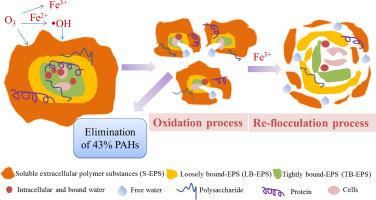Science of the Total Environment ( IF 8.2 ) Pub Date : 2021-11-27 , DOI: 10.1016/j.scitotenv.2021.152015 Yanting Dong 1 , Haiping Yuan 1 , Lu Bai 1 , Dongdong Ge 1 , Nanwen Zhu 1

|
Simultaneous removal of polycyclic aromatic hydrocarbons (PAHs) in the process of enhancement of sludge dewaterability via oxidation of hydroxyl radicals (•OH) and flocculation of Fe3+ by Fe2+-catalyzing O3 were investigated as a novel research focus. The results showed that capillary suction time (CST) and water content of dewatered sludge cake (Wc) were reduced from 57.9 s and 85.1% to 13.6 s and 69.65% under the optimum usage of 60 mg/g dry solids (DS) O3 and 80 mg/g DS FeSO4, respectively. The relevant dewatering mechanism of Fe2+-catalyzing O3 treatment was elucidated. It was found that extracellular polymeric substances-bound (EPS-bound) and intracellular water was dramatically released through destroying sludge cells and EPS gel-like structure by produced •OH. In addition, the results of X-ray photoelectron spectroscopy (XPS), Fourier transform infrared (FTIR) and 13C NMR spectroscopy revealed that •OH oxidized and mineralized hydrophilic organic matters intensifying hydrophobicity of sludge surface. Moreover, Fe3+ generated by oxidation of Fe2+ agglomerated fragmented fine particles into large aggregates and decreased exposure of hydrophilic sites by neutralizing negative charge, which promoted water-solids separation. Meanwhile, sludge surface roughness was decreased which was determined by material type upright confocal laser microscope (CLM). As a consequence, •OH and Fe3+ were mainly responsible for enhancement of sludge dewaterability. Moreover, more than 40% of removal rate of PAHs was accomplished by Fe2+-catalyzed O3 treatment mitigating the environmental risks of PAHs spread.
中文翻译:

Fe2+催化O3工艺同时提高污泥脱水能力和去除多环芳烃的综合研究
作为新的研究热点,研究了通过羟基自由基(•OH)的氧化和Fe 2+催化O 3絮凝Fe 3+提高污泥脱水能力的同时去除多环芳烃(PAHs) 。结果表明,在60 mg/g干固体(DS)O 3的最佳用量下,毛细抽吸时间(CST)和脱水污泥饼的含水量(Wc)由57.9 s和85.1%降低到13.6 s和69.65%。和 80 mg/g DS FeSO 4,分别。Fe 2+催化O 3的相关脱水机理治疗被阐明。研究发现,通过产生•OH破坏污泥细胞和EPS凝胶状结构,细胞外聚合物结合(EPS-bound)和细胞内水被显着释放。此外,X射线光电子能谱(XPS)、傅里叶变换红外(FTIR)和13 C NMR光谱结果表明,•OH氧化和矿化了亲水性有机物,增强了污泥表面的疏水性。此外, Fe 2+氧化生成的 Fe 3+将破碎的细颗粒凝聚成大的聚集体,通过中和负电荷减少亲水位点的暴露,从而促进水-固体分离。同时,通过材料类型立式共聚焦激光显微镜(CLM)测定污泥表面粗糙度降低。结果,•OH 和Fe 3+主要负责提高污泥的脱水能力。此外,通过 Fe 2+催化的 O 3处理实现了 40% 以上的 PAHs 去除率,从而减轻了 PAHs 扩散的环境风险。











































 京公网安备 11010802027423号
京公网安备 11010802027423号